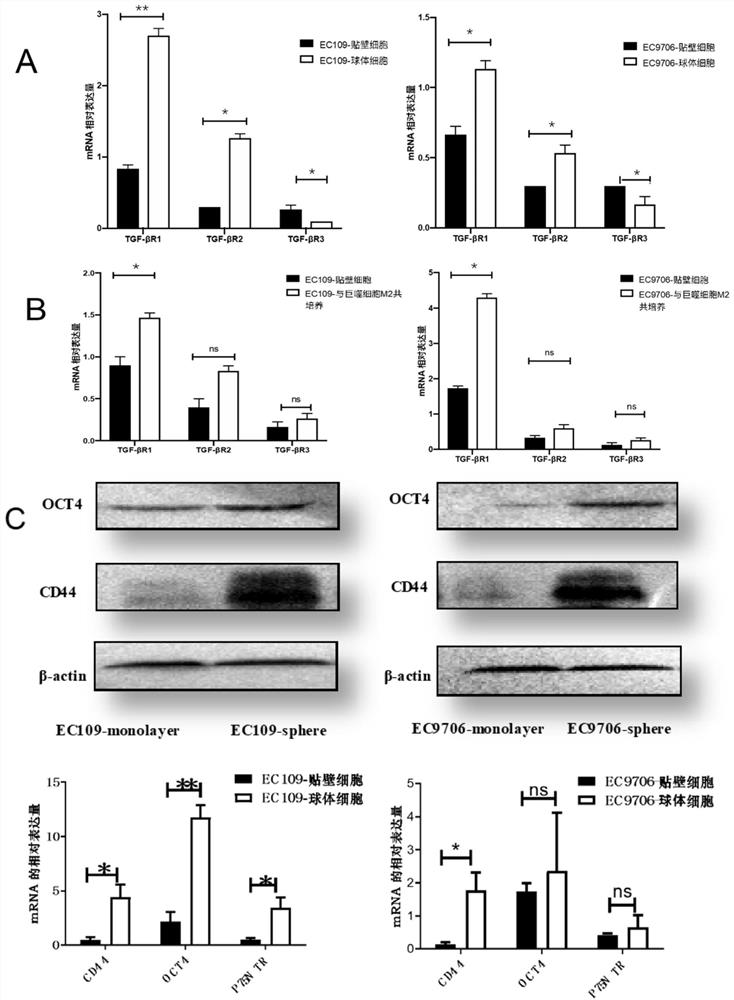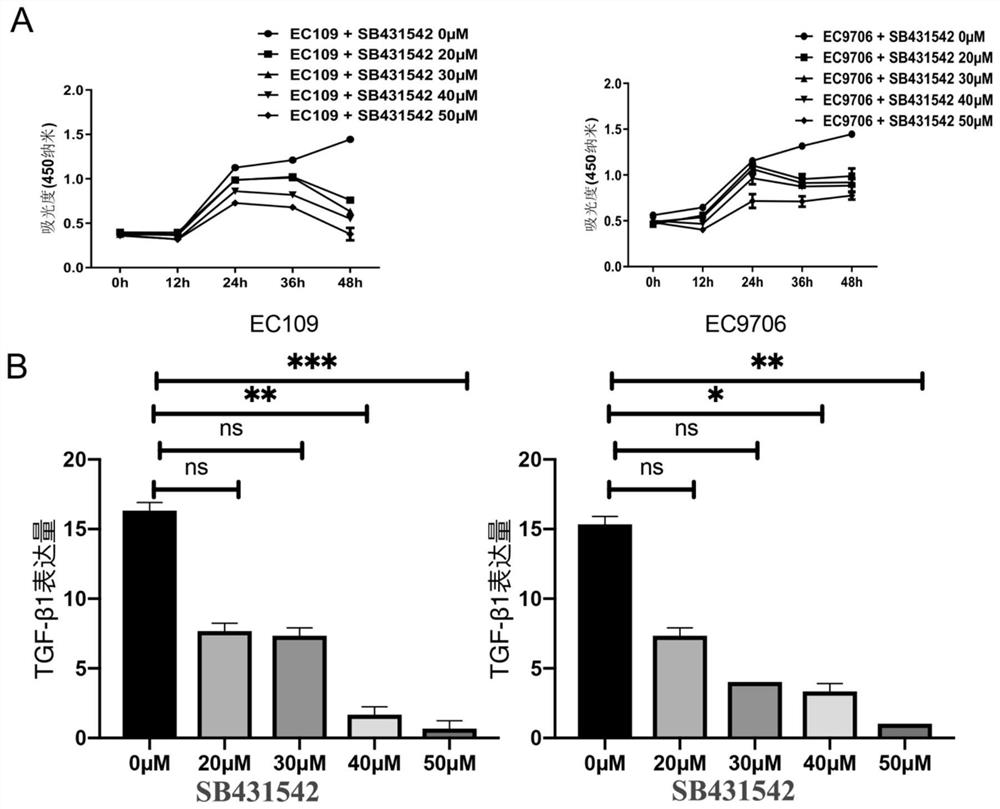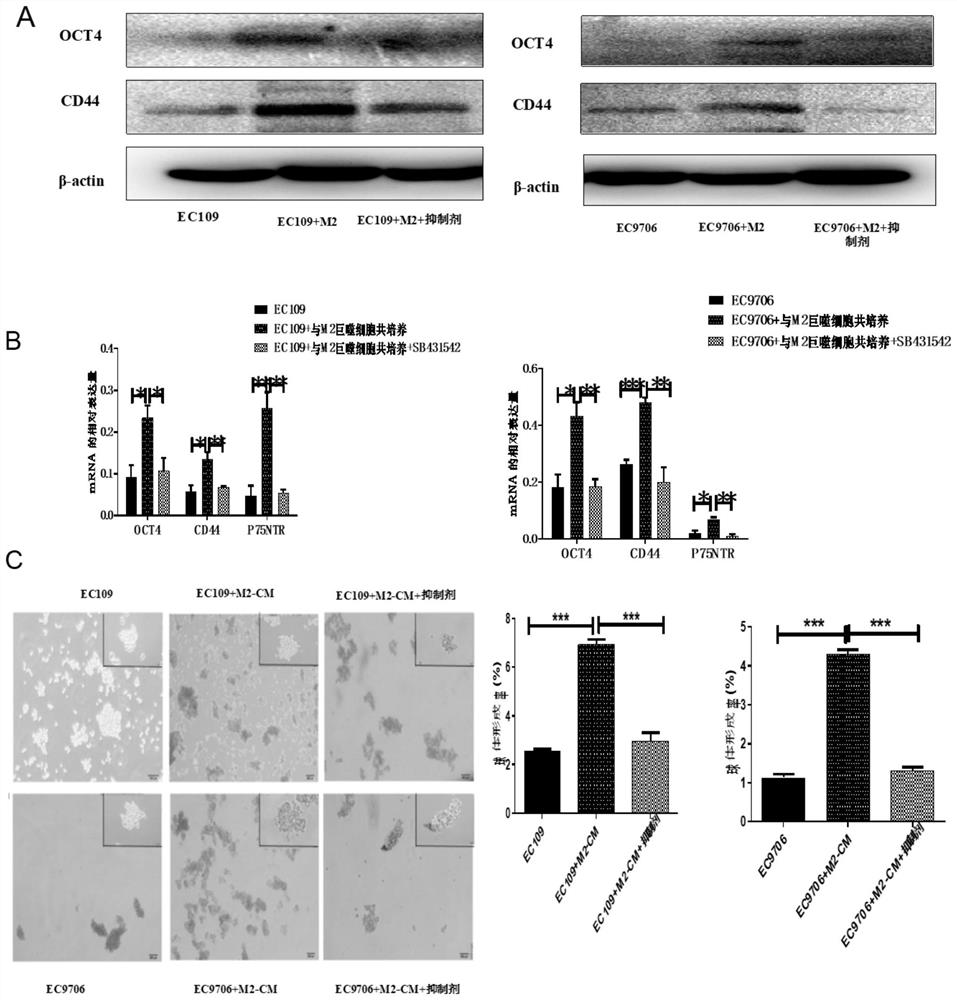Application of substance for inhibiting expression of TGF-betaR1 in treatment and/or prevention of esophageal cancer
A TGF-, esophageal cancer technology, applied in the field of biomedicine, can solve the problems of lost optimal timing, complex pathological changes of esophageal cancer, and failure of chemotherapy
- Summary
- Abstract
- Description
- Claims
- Application Information
AI Technical Summary
Problems solved by technology
Method used
Image
Examples
Embodiment 1
[0070] Example 1. High expression of TGF-βR1 in esophageal squamous cell carcinoma cells and esophageal cancer stem cell spheres after co-culture
[0071] Enrichment of esophageal cancer stem cells by natural screening method in serum-free culture and detection of OCT-4, CD44 and P75 by qRT-PCR NTR The expression of genes related to stem cell characteristics was different in esophageal cancer stem cell spheres (experimental group) and EC109 or EC9706 adherent cells (control group), and the expression of TGF-βR1 in stem cell spheres was detected by Western blot.
[0072] Esophageal cancer stem cell spheres: Inoculate 10,000 esophageal cancer cell lines EC109 or EC9706 in the logarithmic growth phase into an ultra-low adhesion six-well plate containing serum-free stem cell medium (F12 serum-free medium) , after the sphere cells are formed, the tumor stem cell spheres are collected.
[0073] Co-cultivation with M2 macrophages: The esophageal cancer cell line EC109 or EC9706 in t...
Embodiment 2
[0080] Example 2. Preparation of Esophageal Cancer Cells with Reduced Expression of TGF-βR1 and Its Application in Inhibiting Stem Cell Characteristics, Proliferation, Migration and Invasion of Esophageal Cancer Cells
[0081] 1. SB431542 can reduce the expression of TGF-βR1 in esophageal squamous cell carcinoma cells
[0082] Since the inhibitor usually has a certain degree of cytotoxicity, in order to reduce its cytotoxic effect as much as possible, the inventors used multiple time points such as 0h, 12h, 24h, 36h, 48h to detect the TGF-βR1 inhibitor by using the CCK8 method (ie SB431542) the change of cell proliferation ability after treatment, the cells to be tested are EC109 cells or EC9706 cells.
[0083] The specific steps for detecting cell proliferation ability by CCK8 method are as follows: culture the cells to be tested in the cell culture well plate, when the cell content is 10000, add TGF-βR1 inhibitor to the culture, the concentration of TGF-βR1 inhibitor is set ...
Embodiment 3
[0116] Example 3, the role of overexpression of TGF-β1 in promoting the stemness of esophageal cancer cells, and further promoting the proliferation, migration and invasion of stem cells.
[0117] 1. The application of substances overexpressing TGF-β1 in inhibiting the stemness of esophageal cancer cells
[0118] In order to detect the effect of adding the TGF-β1 recombinant agent rhTGF-β1 (product number 100-21, Peprotech (UK)) on the stemness of esophageal cancer, Western Blot, qRT-PCR and sphere culture were used to detect the effect of adding TGF-β1. Changes in the expression of stemness markers and sphere formation rate of EC109 and EC9706 cells after β1 recombinant agent, and the negative control cells (ie, EC109 or EC9706 cells) were used as the control group. Proceed as follows:
[0119]Esophageal cancer cell lines EC109 or EC9706 in the logarithmic growth phase were inoculated at 10,000 cells / well in an ultra-low adhesion six-well plate containing serum-free stem cel...
PUM
 Login to View More
Login to View More Abstract
Description
Claims
Application Information
 Login to View More
Login to View More - R&D
- Intellectual Property
- Life Sciences
- Materials
- Tech Scout
- Unparalleled Data Quality
- Higher Quality Content
- 60% Fewer Hallucinations
Browse by: Latest US Patents, China's latest patents, Technical Efficacy Thesaurus, Application Domain, Technology Topic, Popular Technical Reports.
© 2025 PatSnap. All rights reserved.Legal|Privacy policy|Modern Slavery Act Transparency Statement|Sitemap|About US| Contact US: help@patsnap.com



